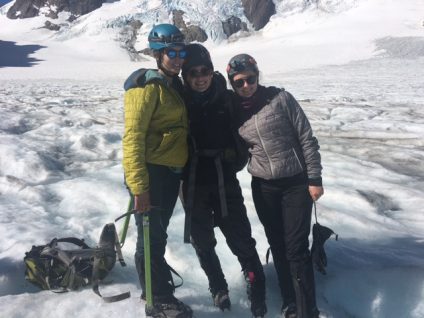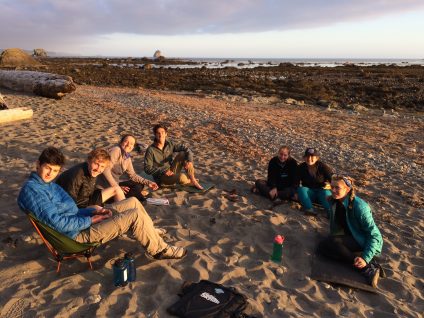Interpreting the language of outdoor retail

When it comes to buying outdoor gear for Adventure Treks (or even for a personal trip), there’s nothing more daunting than trying to decipher every obscure label, material, fabric, and technology that comes with buying even the simplest outdoor item these days.
But Adventure Treks is here to help! This spring, we’re launching our Gear Series: Tips for Buying Outdoor Gear. We’ll discuss some of the materials, technologies, labels, and other features commonly found on outdoor equipment, and attempt to clarify their meaning, use, and how they’re helpful on an AT trip.
Insulated (aka “puffy”) clothing
Warm clothes don’t create heat to keep you warm when it’s cold and/or wet outside. (OK, there are some garments with built-in batteries and heating elements, but let’s not talk about those for now.) Products that are designed to keep you warm in the elements do so with the help of insulation: layers of material that trap warm air from your body and keep it close to your skin, while stopping cold air from the outside getting in.
While insulated bottoms exist, they’re not applicable for Adventure Treks, so we’ll stick to upper body layers like coats and jackets. Some Adventure Treks trips (like Alaska Expedition, Ultimate Northwest, and California Challenge) include insulated jackets on the packing list due to mountaineering activities or colder weather. However, if your child gets cold easily, you can pack an insulated jacket for their trip just in case—just please pack synthetic (see below).
Insulation glossary
 Synthetic: Synthetic insulation comprises long, very fine strands of plastic, piled together to form a fluffy, gauzy-like material, typically formed into sheets and sewn in place between the outer fabric and lining of the product. Because the insulation is plastic, it’s naturally water-resistant and will not collapse and “mat” together when wet. Synthetic items allow the warm air to continue to be trapped against the skin and maintain an insulative property even while wet. Synthetic insulation is almost always less expensive than down insulation, but it will be slightly heavier and bulkier than its down counterpart.
Synthetic: Synthetic insulation comprises long, very fine strands of plastic, piled together to form a fluffy, gauzy-like material, typically formed into sheets and sewn in place between the outer fabric and lining of the product. Because the insulation is plastic, it’s naturally water-resistant and will not collapse and “mat” together when wet. Synthetic items allow the warm air to continue to be trapped against the skin and maintain an insulative property even while wet. Synthetic insulation is almost always less expensive than down insulation, but it will be slightly heavier and bulkier than its down counterpart.
*We ask that students bring synthetic insulated jackets to Adventure Treks so that even if the material gets wet, it will keep your child warm.
Down: Down insulation uses the fluffy and soft down feathers, generally from ducks or geese, that help keep birds warm. These are very light and can trap a lot of air, so down insulation provides a fantastic warmth-to-weight ratio (essentially, it doesn’t need to be heavy to be warm). Because of its light weight and compressibility, down is a great choice when space and weight are an issue. The main drawback to down is that it doesn’t keep you warm when wet: In rainy conditions, these feathers will collapse, clump up, and mat, leaving no space for warm air to be trapped and rendering the jacket ineffective.
Fill power: This term describes the quality of down feathers used in a product, essentially measuring how the “loft” (how fluffy the feathers are, and how much air they can trap). Super fluffy feathers will trap a lot of air, so they will have a higher fill power. Feathers with more of the vein (that hard quill part of the feather) won’t trap as much air and will have a lower fill power. High loft = traps a lot of air. Low loft = not so much air. You’ll see this measurement listed as a number value, most commonly 650, 700, 800, and 900.
- 650–700 fill: Good loft, slightly more quill so feathers sometimes poke through the face fabric of these products. Good warmth-to-weight ratio. Less expensive options
- 800–900 fill: Very high loft and fewer quills on these feathers, so much less likely that feathers will poke through. Excellent warmth-to-weight ratio. Most expensive options
Insulation takeaways
- If purchasing a new insulated jacket, go with down if you’ll be spending a lot of time in dry climates like California.
- If you face the potential for lots of rain and snow (like in Alaska or the Pacific Northwest in winter), go with a synthetic jacket; these are typically a little more durable as well.
- For an AT trip, go with a synthetic jacket or coat; parkas are not necessary for our trips.